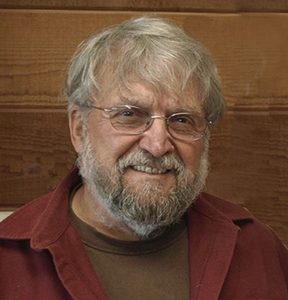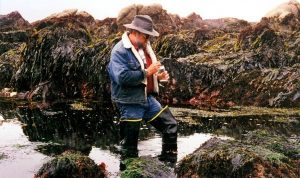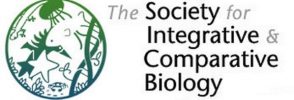David R. Lindberg, University of California Berkeley and Douglas J. Eernisse, California State University Fullerton

John Stuart Pearse, Professor Emeritus in the Department of Ecology and Evolutionary Biology at the University of California Santa Cruz (UCSC), died on July 31, 2020, at the age of 84. John was the consummate invertebrate biologist, receiving his undergraduate degree from the University of Chicago and his doctorate in 1965 from Stanford University. John was renowned for his work on echinoderms, but worked broadly across invertebrate groups, including Placozoa, Porifera, Cnidaria, Annelida, and Mollusca [see taxon bibliographies in Eernisse & Lindberg (2020) and Lindberg et al. (2020)]. Much of this diversity of research was united by his fascination with marine invertebrate reproduction, a topic that he published on throughout his career.
In addition to reproductive studies, John was also an advocate and practitioner of long-term surveys and monitoring of intertidal and nearshore subtidal habitats; one of the longest extended over 40 years at a former sewage outfall at Pleasure Point, Santa Cruz, California (Pearse et al., 2015).
John was an amazing teacher, receiving multiple teaching awards. He was mentor to a cadre of postdocs and graduate students, and to the hundreds of undergraduates who took his courses in invertebrate zoology, intertidal biology, and kelp forest ecology. In addition, many were ‘introduced’ to the Society for Integrative and Comparative Biology (SICB) through John.
Service to professional societies and natural history museums also was important to John. He served as president of the Western Society of Naturalists (1983), Santa Cruz City Museum Association (1985–1986), City Board of the Pacific Grove Museum of Natural History (2014–2019), the International Society of Invertebrate Reproduction (1995–1998), California Academy of Sciences (1997–2003), and the UCSC chapter of Sigma Xi (1997–1999).
At SICB John served as Program Officer (1998–2001), President (2007–2008), and Past President (2009–2011). As program officer John and his fellow committee members re-organized scheduling of contributed oral and poster presentations. They had the divisional program officers meet to integrate presentations from different divisions into a more coherent topic-driven program for the annual meetings. This effectively mixed the interests of many of the SICB divisions and facilitated the exchange of ideas and viewpoints, an integration which was generally lacking at meetings of more specialized societies. The restructuring reflected John’s belief that ‘cross training’ (Pearse 2003) was fundamental to the development of modern integrative and comparative biologists (see below). As president, John was also involved with the overhaul of the Society’s journal – Integrative and Comparative Biology – with the appointment of a new editor, new publisher, and the implementation of an electronic system for submission, review, editing, and acceptance of manuscripts which provided for more consistent and rapid publication of symposia (Heatwole et al. 2007).
John’s commitment to SICB corresponds well with his broadly comparative research approach and interests. In an analysis of John’s publications in the Web of Science database, an internal algorithm categorized John’s publications into 25 non-exclusive categories, the top five being Zoology, Environmental Sciences, Ecology, Marine, Freshwater Biology, Reproductive Biology, and Physiology. These and the other 20 categories reflect John’s passionate curiosity for a legendary range of biological questions and organisms, his impressive mastery of experimental design, his global experience studying polar, temperate, and tropical faunas, and his 60 years of scholarly contributions. These categories also correspond well to SICB’s divisions and the expertise of numerous colleagues with whom he engaged at annual meetings. SICB was also where students would often meet the venerable ‘Professor Pearse’ for the first time, while his own students would begin career-long associations with the Society.

John’s research was an outgrowth not only of his immense curiosity but also his vast and deep zoological knowledge, whether the topic of discussion involved organismal biology, community ecology, environmental activism, or cutting-edge trends in science. In his research John combined the best aspects of a field naturalist and rigorous experimentalist (e.g., Pearse et al. 1986) with the traits of an outstanding comparative biologist. However, John was never averse to change. He worked rigorously to maximize the interactions between researchers with diverse interests and assisted with the modernization of the Society’s journal. Lastly, John wanted to revitalize the training of modern integrative and comparative biologists (Pearse 2003) and argued for a new program that featured the training of modern naturalists. His vision was to have students and their mentors engaged in synthetic pursuits, be as comfortable in the lab as in the field, integrating widely different disciplines, approaches, techniques, and taxa, and ambitiously advancing the study of well-defined, fundamental questions.
SICB benefited immeasurably from John’s service. Like others, he envisioned a new role for 21st century naturalists, who regardless of taxon, habitat, geologic time period, or method of investigation would be well prepared to document the integrated and comparative biology of life.
For additional biographies and bibliographies see: Pearse (2007), Hadfield (2007), and Eernisse & Lindberg (2020). We thank Vicki B. Pearse for comments.
References
Eernisse, D. J. & D. R. Lindberg. (2020). In Memoriam John S. Pearse. Invertebrate Biology, 2020: 139:e12309.
Hadfield, M. G. (2007). A 70th birthday tribute to an outstanding marine biologist: John S. Pearse. Bulletin of Marine Science, 81(2): 160–165.
Heatwole, H., N. Cochran, J. S. Pearse, & C. Kennedy. (2007). Editorial. Integrative and Comparative Biology, 47: 1–3.
Lindberg, D. R., T. M. Gosliner, D. J. Eernisse. (2020). John Stuart Pearse (1936-2020) American Malacological Society Newsletter, (Fall 2020): 18-21.
Pearse, J. S. (2003). The promise of integrative biology: resurrection of the naturalist. Integrative and Comparative Biology, 43: 276-277.
Pearse, J. S. (2007). The integrative and comparative underpinnings of my Antarctic research. SICB Newsletter, (Fall 2006): 2-4.
Pearse, J. S., W. T. Doyle, V. B. Pearse, M. M. Gowing, J. T. Pennington, E. Danner, & A. Wasser. (2015). Long-term monitoring of surfgrass meadows in the Monterey Bay National Marine Sanctuary: Recovery followed by stability after the termination of a domestic sewage discharge. Marine Sanctuaries Conservation Series ONMS-15-10. U.S. Department of Commerce, National Oceanic and Atmospheric Administration, Office of National Marine Sanctuaries. 42 pp.
Pearse, J. S., D. J. Eernisse, V. B. Pearse, & K. A. Beauchamp. (1986). Photoperiodic regulation of gametogenesis in sea stars, with evidence for an annual calendar independent of fixed daylength. American Zoologist 26: 417-431.
